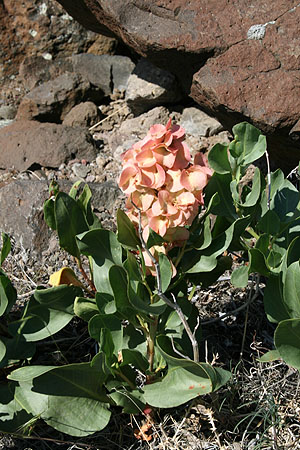Caņaigre, Sand Dock, Wild Rhubarb
Rumex hymenosepalus Torrey. Polygonaceae Buckwheat Family
Docks are leafy herbaceous plants that were widely used by native peoples for their edible greens, although the plant had other uses as well. Sand dock, or caņaigre, is native to the Trans-Pecos region and most of the Southwest. It grows from a tuberous root with erect leaves that branch from its base. Its favorite habitat is deep sand on streams, hence the name sand dock. A relative plant, Curly dock (Rumex crispus) is a European introduction that has spread across North America.
Archeology. We know of no archeological occurrence of sand dock in the Trans-Pecos. However, there are many documented accounts of the use by Native Americans elsewhere of its seeds, leaves and tuberous roots, and it was almost certainly used in the Trans-Pecos as well. Unfortunately, roots and leaves are seldom preserved at archeological sites. Tubers, even when they are preserved, are difficult to identify.
Food. The leaves contain oxalic and citric acid and the leaf stalks (petioles) malic acid, so the greens should be boiled with at least a couple of changes of water. The Cahuilla, however, report that the stalks were crisp and juicy (Bean and Saubel 1972:134). Other groups boiled the leaves, or roasted/steamed them on hot coals. The Pima and the Papago used the greens after boiling or roasting them on hot coals (Castetter and Underhill 1935:46; Curtin 1949).
Seeds were parched, pounded or ground, and mixed into porridge or gravy by the Kawaiisu (Zigmond 1981). After roasting the seeds, the Pima would grind them, mix them with water and shape them into flat cakes (Curtin 1949).
Medicine. The root contains tannin and as well as an abundance of starch (Kress 2007). The root was dried and ground into a powder and applied as a poultice to wounds and boils by the Pima (Russell 1908; Curtin 1949). The Pima also chewed the root or prepared a decoction for use as a gargle to soothe a sore throat (Curtin 1949). The Papago had a similar use, drying and pounding the root and taking it for a sore throat. In the northern range of the plant, the Pawnee would use the root to treat diarrhea. The Ramah Navajo obtained caņaigre from relatives living within its natural range and utilized a decoction of the root to stimulate milk production, both in goats and in women (Vestal 1952).
Dye and other applications. The rich tannin content made the root a choice for producing vegetable dye. The Navajo were especially adept at using the root to dye yarn, although obviously this is a recent application, as sheep were introduced by the Spanish.
Depending on how the root is processed, the dye could be yellow, brown, green, or orange (Elmore, 1944). The Pima soaked basket materials (young, limber willow branches or withes) in a solution if crushed and dried caņaigre root to dye them yellow-brown (Curtin 1949). If they wanted a brown color, they simply soaked them longer.
The high tannin content of the root made it useful for tanning hides. The Pima dried the root, crushed it and mixed it with water. The leather was then soaked in a vat with the mixture, for a long time, turning the leather a brownish red. The Cahuilla also used the caņaigre root for tanning hides (Curtin 1949; Bean and Saubel 1972).
References
Bean, Lowell J. and Katherine S. Saubel
1972 Temalpakh: Cahuilla Indian Knowledge and Usage of Plants. Malki Museum Press. Morongo Indian Reservation, Banning, California.
Castetter, Edward F. and Ruth M. Underhill
1935 The Ethnobiology of the Papago Indians. Ethnobiological Studies in the American Southwest. Vol. II. The University of New Mexico Bulletin, Biological Series 4(3). Albuquerque.
Curtin, Leonora S. M.
1949 By the Prophet of the Earth: Ethnobotany of the Pima. Reprint of book published by San Vicente Foundation [1984]. University of Arizona Press. Tucson.
Elmore, Francis H.
1944 Ethnobotany of the Navajo. University of New Mexico Bulletin. Monograph Series 1(7). University of New Mexico Press. Albuquerque.
Kress, Henriette
Accessed 10/2007. http://www.henriettesherbal.com - Copyright 1995-2007 Henriette Kress.
Russell, Frank
1908 The Pima Indians. In Twenty-sixth Annual Report of the Bureau of American Ethnology, No. 26. [1904-1905], pp. 17-389. Washington, D.C.
Vestal, Paul
1952 Ethnobotany of the Ramah Navaho. Papers of the Peabody Museum of American Archaeology and Ethnology 40 (4). Harvard University. Boston.
Zigmond, Maurice L.
1981 Kawaiisu Ethnobotany. University of Utah Press. Salt Lake City.
